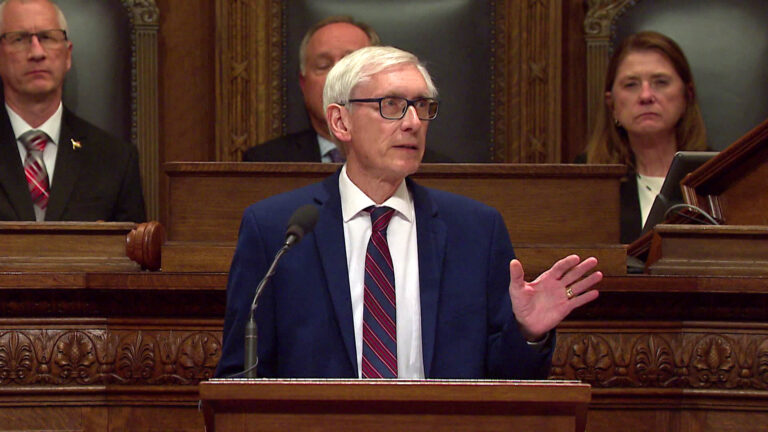Rich Budinger:
A lot of people talk about it as a gold rush, but, you know, it’s an industrial sand rush.
Frederica Freyberg:
And this is what the rush is all about, so-called frac sand, sand that feeds the oil fields in places like North Dakota. Where drillers mix the frac sand with water and chemicals, and force it underground to fracture and release shale deposits of the oil and gas.
Man:
What is that coming out of there?
Man 2:
It’s water and a little bit of crude oil.
Frederica Freyberg:
The process requires the precise kind of sand that can be mined in the hills of western Wisconsin, like at this mine in Menomonie, owned by Fairmont Minerals of Ohio.
Rich Budinger:
It’s the roundness of the grain. It’s the strength of the grain. And it’s the size of the grain.
Tom Woletz:
Two and a half years ago we had five or six sand mines and processing plants. Now we’ve got 40 to 50 processing plants. And, you know, depending upon how you're counting them, over 100 mines.
Frederica Freyberg:
This map shows the locations of operating and approved sand mines that have sprung up across the state. They’re producing more than 12 million tons of frac sand a year, worth billions of dollars. And big oil companies are still prospecting for more. It’s sandstone ridges like this one, a familiar part of the landscape in places like Dunn County, that become surface mines. Here, machinery leveled off about 15 feet of this hill.
Rich Budinger:
Then we come through the actual reserve body itself. That is then drilled and blasted. And then the sand then goes from that point into– gets introduced into the wet process, where all the clays and the fine sands are washed off.
Frederica Freyberg:
The sand is then dried and put into piles, loaded into trucks and delivered to railcars, for the trip west to the oil fields.
Dave Meixner:
The train traffic has increased quite a bit over the past year in particular. Also, now there’s traffic of the oil being shipped back from the Dakotas. It is really noticeable. They’re bigger. They’re heavier. They’re louder.
Frederica Freyberg:
In the tiny town of Maiden Rock along the Mississippi River, the locals have noticed the uptick that came with the new rail spur for the sand, frac sand that comes from an underground mine spanning more than 2.5 square miles which is also owned by parent company, Fairmont Minerals. One of the largest producers, the company owns three mines in the state. The sandstone tunnels of its two underground operations, protected from outside elements, allow for year-round mining of the valuable frac sand. Last year, the company invested tens of millions of dollars into a new processing plant at Maiden Rock, allowing the recycling of the water used to wash the sand, and the direct conveyance of the sand to its nearby railcars. Evelyn Johnson has the big river in her front yard, the mine just next-door.
Evelyn Johnson:
They’ve been very good neighbors from the time they started.
Frederica Freyberg:
In Pierce County and in Dunn, the sand company reports giving more than $300,000 in a year to local schools and non-profits. Evelyn Johnson likes the philanthropy as well as the jobs.
Evelyn Johnson:
I mean, it provides employment, I mean, wonderful employment. I mean, for so many in the area.
Frederica Freyberg:
Fairmont Minerals employs 123 in the state, not counting spin-off employment like truck drivers. The Wisconsin Center for Investigative Journalism reports that when existing mines and those being built are fully operational, the industry is expected to employ nearly 3,000 people. But owners of the Smiling Pelican Bakery in Maiden Rock’s main street worry the areas real bread and butter of tourism is hurt by increased truck and train traffic. And Dave Meixner says many local residents worry about what frac sand means to their health.
Dave Meixner:
I think it’s good that Wisconsin is open for business because we need the jobs, but also I think with this industry there has to be strict regulations to protect the citizens.
Tom Woletz:
We certainly have a lot of regulation on these mines with the air permits, with the high-capacity well permits, with the storm water permits, endangered and threatened species review. You know, they’re pretty well-regulated here.
Crispin Pierce:
particles, and you can see they're lining the test tube
Frederica Freyberg:
Not so, says UW-Eau Claire professor of environmental public health, Crispin Pierce.
Crispin Pierce:
I’m really quite disappointed. I think the DNR has done a real disservice to the people of Wisconsin.
Frederica Freyberg:
Pierce is talking about the lack of state regulation of something called crystalline silica. Tiny and dangerous particles in frac sand that can cause fatal scarring of the lungs and cancer if inhaled. The silica can escape into the air coming, potentially coming off sand piles or trucks if dust reduction controls are not in place.
Crispin Pierce:
You talk about lung cancer. You talk about silicosis and breathing difficulties. So it truly is I think a very frightening issue for people.
Frederica Freyberg:
Pierce has a desk-top air monitor he uses to show how easily those particulates in frac sand go airborne.
Crispin Pierce:
If we get above a level of 15 here, we’re above the EPA standard. So if we take just a bag of this Hoffman Hills raw sand and simply just open the bag, we’re at levels that are 50, 100, 200, 300 times higher than the EPA standard.
Frederica Freyberg:
Pierce and others petitioned the state DNR two years ago to regulate crystalline silica exposure that the general public. Exposure that might occur in communities near sand mines. In January of this year the DNR denied the petition citing a state Department of Health study that said, We have found no published evidence of health effects from intermittent or occasional off-site exposures to people living near sand mining operations. Pierce would like to gather the evidence himself required to get the DNR to regulate silica exposure and is staging monitors at a large sand mine to test the air. He expects to submit his results to the DNR. Meanwhile, he consults with local communities considering sand mine permits. One such community in Buffalo County recently rejected such a permit for a facility in these hills. That county’s top health official saying, There is no proof that air quality is not negatively impacted by industrial sand mining operations.
Tom Woletz:
I think if people are complying with the permits, I think the regulations are adequate to protect the environment and the people living around these plans. We’ve really seen no big issues with them.
Frederica Freyberg:
Mine manager Rich Budinger says even though the DNR says current regulations are adequate, his company has installed its own air monitors at its Maiden Rock facility, and in the town.
Rich Budinger:
We decided we weren’t required to install the ambient air monitors, but we went ahead and thought it would be a good idea to do that anyway just to collect the data and to prove that it was not an impact outside of our operations.
Frederica Freyberg:
Budinger says his company is dedicated to being good stewards. Andy Gansberg sure hopes so. His property sits right next to the Fairmont Mineral’s Menominee mine, sand piles visible from his family’s home.
Andy Gansberg:
The only thing we have been blessed with, if you call it blessing, is we found out that the wind usually blows north, away from us.
Search Episodes

Donate to sign up. Activate and sign in to Passport. It's that easy to help PBS Wisconsin serve your community through media that educates, inspires, and entertains.
Make your membership gift today
Only for new users: Activate Passport using your code or email address
Already a member?
Look up my account
Need some help? Go to FAQ or visit PBS Passport Help
Need help accessing PBS Wisconsin anywhere?

Online Access | Platform & Device Access | Cable or Satellite Access | Over-The-Air Access
Visit Access Guide
Need help accessing PBS Wisconsin anywhere?

Visit Our
Live TV Access Guide
Online AccessPlatform & Device Access
Cable or Satellite Access
Over-The-Air Access
Visit Access Guide
 Passport
Passport


















Follow Us